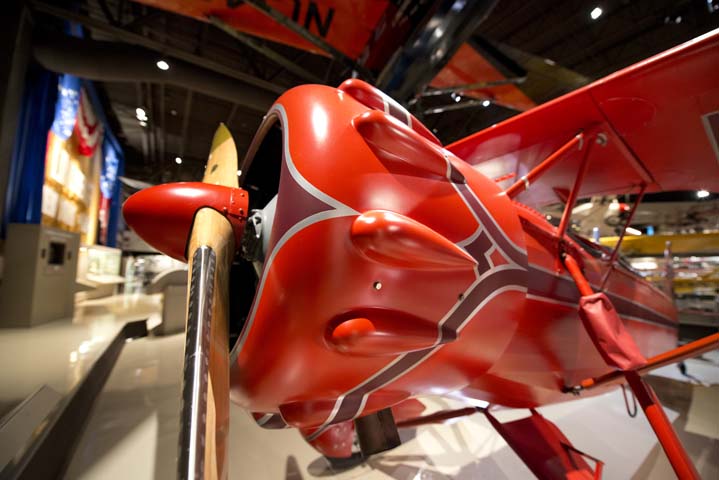1933 Davis D-1-W - NC13456
Location: Pioneer Airport
The Davis aircraft story begins with two brothers named Wilson and Harvey Doyle. They were 1925 graduates of Harvard and Yale, respectively, and left their hometown of Charlotte, North Carolina, for Detroit, Michigan, then a center of aviation activity. After some time spent working for others and trying to obtain financial backing to start an aircraft company, they moved to Portsmouth, Ohio, where they came in contact with William Burke of the Vulcan Last Company. Burke backed their plan to build a two-place, tandem, open-cockpit parasol sportplane and the Vulcan Aircraft Division began design work in a rented second floor room and construction in a former street car barn in Portsmouth.
The result was the Vulcan American Moth. Burke chose the name in order to take advantage of the popularity of the British de Havilland Moth series of biplanes. A publicity tour of Florida ensued in which a parachutist, Benny Martinez, jumped from the Moth carrying a set of Vulcan golf clubs. The plane was a hit, but the relationship among the principles was deteriorating and the Doyle brothers left to start their own Doyle Aircraft Company in Baltimore. They produced 14 Doyle Orioles, which were similar to the Moth, before bankruptcy ended the effort.
Meanwhile, Vulcan updated the engine from a 60-hp Detroit Air-Cat to a Warner radial and the aircraft became the Vulcan V-3. It finished second in the National Air Races A Division, New York to Los Angeles Derby. Later it took first in the Los Angeles to Cincinnati race at 90.3 mph. Shortly after these achievements, William Burke died leaving the company’s future in doubt.
Walter C. Davis was a former WWI pilot who had been working in his family’s business, the Davis Automobile Company of Richmond, Indiana, when it was sold in 1928. Redirecting his talents back to flying, he purchased the production rights to the Vulcan V-3 and began work on the first Davis aircraft in March 1929. He hired Vulcan test pilot, Pat Love, and engineer Dwight Huntington and opened his factory in Richmond.
Huntington’s slight re-design of the aircraft included adding the gently curved leading edge to the vertical stabilizer. Davis then set up dealers in California, Dayton, Boston, Seattle, Salt Lake City and Pittsburgh. Air racing success continued in 1929 and all seemed well. The advent of the Great Depression ultimately led to the demise of Davis Aircraft, but the company struggled on.
In December 1929, two new models were engineered with different engines, the D-1 with a 65-hp LeBlond and the D-1K with the 100-hp Kinner K-5. Both models were certificated, but sales lagged. Davis countered by aggressively pursuing direct sales to buyers and attended trade shows in St. Louis, Detroit and New York. He added the D-1-66 (later D-1-85) with an 85-hp LeBlond engine and cut prices, but then lost the entire finished inventory of planes to a fire.
Through all this, the Davis airplanes continued to shine at air racing. Art Chester bought a D-1-85 which he flew to victory in the 25-mile event at the National Air Races in September 1930. Unfortunately, the commercial market for airplanes just wasn’t there and in 1932 Davis turned to the production of lawn mowers. A few additional planes left the factory in 1933 but they were apparently made up from existing parts inventory or airframes returned to the factory for various reasons. They received new serial and registration numbers.
NC13546 was one of those aircraft Davis produced from existing parts in 1933. The first owner was William Moffett who purchased it on November 22, 1933. The data plate says it was manufactured in February 1934, but there is speculation that Moffett bought the engine separately and there was a delay in getting it installed. By June 1934, Moffett had transferred ownership back to Davis Aircraft and the next owner was Art Chester. He may have intended it to be a replacement for his Davis NC150Y which was destroyed in a crash at the 1932 Nationals or it may have been part of his Davis dealership inventory as he only owned it for 45 days.
The aircraft was resold many times. Nineteen are documented through registrations, but there may have been more. Clancy Hess owned it as a teenager but lost it in 1940 when he couldn’t make the payments. In 1944, Carl Schultz, EAA 2, was an American Airlines mechanic when he bought NC13546 for $500. Schultz designed and installed the brake system still on the aircraft.
Paul Ollenburg of Waukesha, Wisconsin, bought the plane in 1958. He had Robert Huggins convert it from a D-1-85 with an 85-hp LeBlond to a D-1-W with a 145-hp Warner Super Scarab. From Ollenburg the Davis went to Dale Crites, manager of the Waukesha airport. He owned the plane from 1967 until 1983.
Gene Chase opened a fortune cookie in 1983 and found the message, “You will have an unexpected treasure.” It was just a few days later that he learned that Dale Crites had the Davis up for sale. Chase owned the airplane until donating it to the EAA Museum in 2006.
Aircraft Make & Model: Davis D-1-W
Length: 21 feet 6 inches
Wingspan: 30 feet 3 inches
Height: 7 feet 3 inches
Empty Weight: 1,134 pounds
Gross Weight: 1,471 pounds
Seats: 2
Powerplant: Warner Super Scarab SS-50A
Horsepower: 145 hp
Cruise Speed: 123 mph
Maximum Speed: 142 mph




